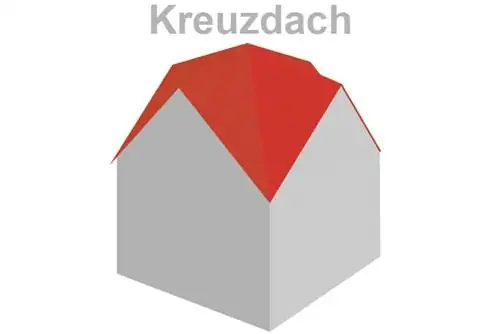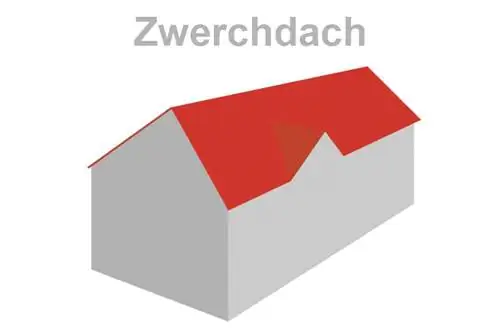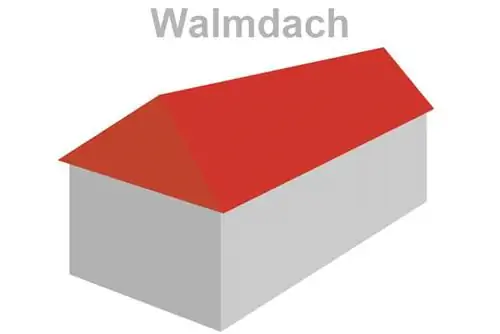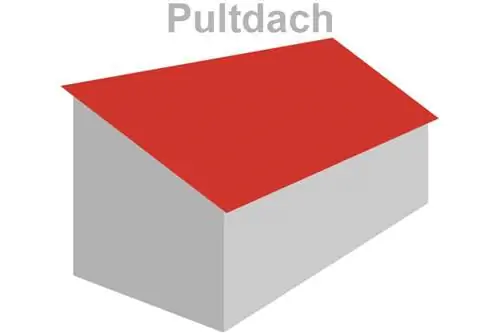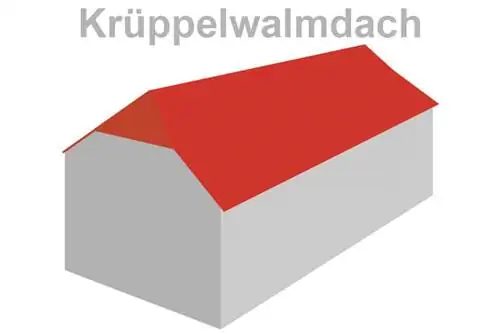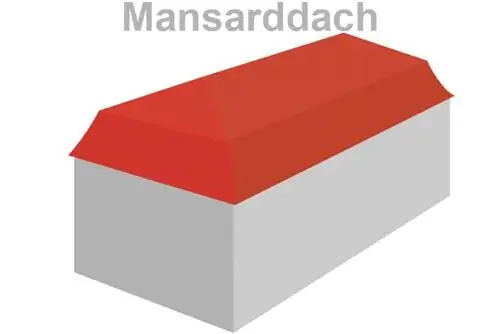- Author admin [email protected].
- Public 2023-12-17 03:39.
- Last modified 2025-06-01 06:48.
Many people who see it will probably not even recognize it as such - the cross roof. Visually, it is very reminiscent of the most well-known roof shape, the gable roof. In fact, the cross roof is visually and structurally closely related to the gable roof. We will explain its characteristics, advantages and weaknesses in a clear and easy-to-understand manner below.
The cross roof - what’s behind it?
The creation of the cross roof is as simple as its obvious shape suggests. If, instead of a building with one main direction, a building with two mutually perpendicular main directions, i.e. a cross shape, is to be roofed, you take the well-known gable roof and duplicate it by these 90 degrees. The result is a roof with two equivalent ridge directions and two usually at least approximately equivalent roofs, as well as a total of four equivalent ridges - the cross roof. However, this equivalence should not be confused with the fact that these roofs are identical. Because they can vary in their width, height and, as a result, eaves height. Even variants with different roof pitches are known. The characteristic feature of the cross roof is the same ridge height of both gable roofs.
Similarities to other roof shapes
In terms of appearance, the cross roof can be very reminiscent of other sub-forms or additions to the gable roof:
- Transverse or mid-gable
- Gable roof dormers
- Roof loggias with gable roof
Depending on the viewing angle, these don't even have to be arranged on both sides, but one such element is enough to give the impression of a cross roof depending on the location.
The demarcation
Although the transitions between a gable arranged on both sides of a gable roof and a real cross roof are certainly not carved in stone, this can be clearly recognized by the identical height of both ridges in conjunction with the continuity of both ridges. Although an extremely pronounced gable can raise the ridge to the level of the main ridge, it usually lacks the opposite counterpart that would make it a real cross roof.
The construction
Theoretically, it is possible to design a cross roof, analogous to the classic gable roof, either as a rafter roof with mutually supporting rafters, or as a purlin roof with load-bearing sleepers, central purlins and ridge. However, this statement only applies to the actual roof areas with opposing roof areas. In the intersection area, however, the roof surfaces and their structural elements meet at right angles, so that there is no mutual support effect. This means that when erecting a rafter roof, the roof intersection must always be strengthened with additional frames or supports. The purlin roof, which works with additional supporting elements from the outset, results in a clearer construction.
Constructive details
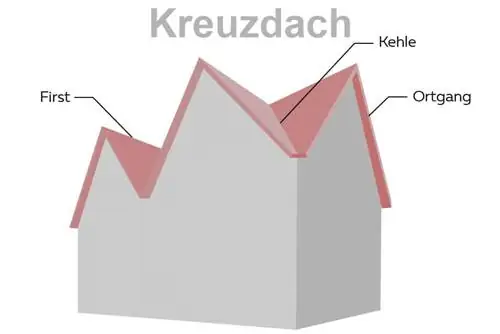
Particular attention is paid to the structural details of the cross roof. Because of the equal intersection of a total of two gable roofs or ultimately eight individual roof areas, connection and transition details appear in large numbers:
- Throat: Cutting line to be formed between the individual roof surfaces in both the supporting structure and the roof covering
- Section lines for roof surfaces: to be solved with regard to the supporting structure, roof covering, snow guards, etc.
- Firste: four ridges meeting at one point
- Purlins: statically intercepted intersections of the individual purlins of the roof surfaces
- Drainage: eight individual gutters, each with a slope, which meet in pairs
Static Challenges
The biggest static challenge of the cross roof is the fact that in the pure form of this roof there is no supporting element that runs continuously from ridge to ridge. There is always a change of direction in the intersection area of the roofs, which must be designed statically and, if necessary, supported to transfer loads. In practice, this often results in a cross roof in the crossing under the meeting ridges with a supporting frame structure that absorbs the loads of the purlin ends and the ridge intersection. It can be recognized by the four characteristic supports under the intersection of the central purlins.
NOTE:
A very common solution to overcome these static difficulties is to offset the two ridges from each other by the height of a ridge beam. As a result, a ridge can be built continuously and serve to absorb the loads of the two roof parts that are perpendicular to it. Strictly speaking, this implementation is no longer a real cross roof, but in terms of design the difference is only marginally noticeable due to the offset of around half to a full tile height. The benefit for the interior, on the other hand, is enormous due to the largely eliminated support structure in the intersection area.
Costs
If you think about using a cross roof for your planned building, sooner or later the question of construction costs will certainly arise. Even if it is hardly possible to give a binding indication of the costs apart from a specific object, individual tendencies can be easily identified and aspects mentioned which, for example, mean an increase in costs compared to the classic, simple gable roof, or which also have a cost-reducing effect.
Cost-increasing aspects:
- High design effort
- High number of details to solve
- High proportion of envelope area in relation to volume and base area
Cost-reducing effects:
- Simplistic alternative via offset ridges
- Good utilization of angular buildings and difficult-to-build land possible (additional roof costs offset by larger/more usable building area)
- High degree of repetition of structural details through fourfold repetition of the comparable roof or roof part
In conclusion, it can be clearly stated that the cross roof itself is certainly a very expensive roof shape. It becomes economically advantageous especially when it enables a building form that allows a property to be used better and more intensively, so that my increase in roof costs is accompanied by more usable or living space.
Advantages and disadvantages
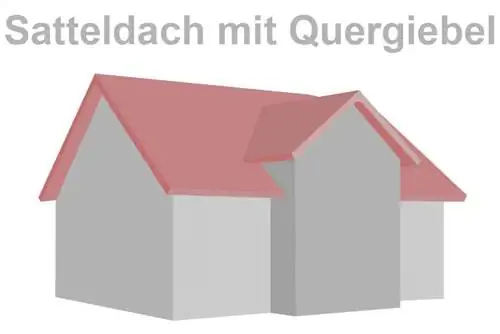
Even if the general advantages and difficulties of the cross roof have already been mentioned again and again, they will be summarized and summarized here again.
Advantages
- Allows dense development of difficult properties
- With structural simplification through height-offset ridges, easily usable roof space
- Balanced appearance thanks to equal roof parts and gable
Disadvantages
- Constructively complex
- Only possible for floor plans with a rectangular arrangement
- Comparatively high costs, which can usually be offset by advantages in building design
- High susceptibility to damage due to high level of detail points, such as valleys, ridges, verges and eaves
Tip:
Before you decide to plan a cross roof, it is always worth considering alternatives such as the gable roof with a cross gable or dormer windows. Because the central middle of the four roof parts also has an impact on the building below due to the necessary transfer of loads there.

